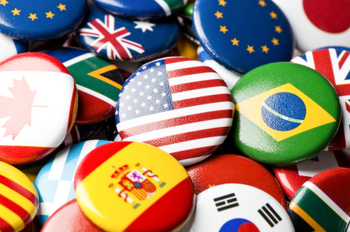Recent study finds correlation between increased regulatory burdens and decreased international competitiveness.
A new study suggests that increasing regulation may be contributing to a decline in American competitiveness.
new study suggests that increasing regulation may be contributing to a decline in American competitiveness.
Released by the
Mercatus Center at
George Mason University, the study concludes that the United States has become less internationally competitive as its private sector regulations have grown more onerous. While the study’s authors, economists
Steven Globerman and
George Georgopoulos, do not claim to identify any causality between regulation and competitiveness, they say they find hints of such a relationship in the available academic literature.
First, they find that the United States saw a relative decrease in productivity growth rates between 2006 and 2010 by measuring total output against total labor input, but no such decrease when measuring total output against all real inputs, including labor and capital investments.
Second, they find a relative decrease in growth of the manufacturing sector, but a relative increase in the growth of the financial and business services sector during the same time period. Based partly on this data, the authors
conclude that “productivity estimates do not show evidence of any marked deterioration of U.S. international competitiveness, although they hint at some moderation of U.S. outperformance in recent years.”
On the other hand, Globerman and Georgopoulos claim that a deterioration in American international competitiveness shows more clearly in the
World Economic Forum’s
Global Competitiveness Report, which gathers subjective evaluations of global competition from corporate executives. According to Globerman and Georgopoulos’s reading of that report, the United States ranked first among seventeen OECD countries for its climate for innovation in 2005 but had slipped into a tie for third by 2011. The authors
believe this slide shows a decline in U.S. global competitiveness because innovation is linked to technological change, “which is a major contributor to productivity growth.”
Globerman and Georgopoulos cite additional surveys that lead them to conclude that managers of global companies are less optimistic about American international competitiveness than they have been in the past. For example, responses to a survey in the World Competitiveness Yearbook, produced by a
Swiss business school, reflect a belief that the United States is now significantly more threatened by relocation of both production and R&D than it was in 2000. In addition, Globerman and Georgopoulos say that a
Harvard Business School survey of its alumni indicates that a respondent in the United States was significantly more likely to consider relocating business activities abroad than was a survey respondent outside of the United States.
After concluding that the United States’ competitive advantage may have weakened in the past half-decade, Globerman and Georgopoulos proceed to investigate changes in the American regulatory environment. Relying on data collected from various survey responses, they
conclude that “the preponderance of evidence … suggests that the burden of regulation on the private sector has increased in the United States relative to other OECD countries, at least since 2005.” The authors rely on survey data, as opposed to quantifiable measurements, because in their view there is no scholarly consensus on how to quantify a country’s regulatory regime.
The World Economic Forum’s
Global Competitiveness Report provides the bulk of Globerman and Georgopoulos’s data. According to the authors’ reading of that report, the United States was ranked seventh in 2005 for having the smallest burden of government regulation but slipped to eighth by 2011. In 2005, the United States ranked third for the fewest number of days required to start a new business, but by 2011 it had slipped into a tie for sixth.
Perhaps most striking, say Globerman and Georgopolous, is that the United States slipped from being tied for third for perceived strength of property rights in 2005 to fifteenth by 2011. They note, however, that there was no change in the U.S. ranking based on respondents’ assessments of the number of procedures required to start a new business.
They cite a second survey, the World Competitiveness Yearbook, for further support that the regulatory environment has deteriorated. According to their analysis of that survey, the regulatory environment in the United States
improved substantially relative to other OECD countries between 2000 and 2005, but it “deteriorated, if anything” after 2005.
Finally, Globerman and Georgopoulos cite a
World Bank index rating countries on the quality of their overall regulatory environment. According to the authors’ reading of the study, the United States scored lower than only four other OECD countries in 2005 but it scored behind ten countries in 2010.
Although the authors do not provide any proof of causation between increased regulatory burdens and decreased competitiveness, they review other studies and conclude that “the available statistical evidence, on balance, tends to show that regulations, particularly in product and labor markets, harm productivity performance.” And productivity performance, they note, is closely tied to American international competitiveness.

 new study suggests that increasing regulation may be contributing to a decline in American competitiveness.
new study suggests that increasing regulation may be contributing to a decline in American competitiveness.


